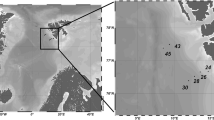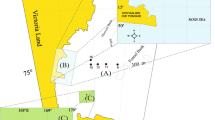Abstract
The polar summer metabolism of the planktonic communities in the Greenland Sea was surveyed in July 2007. Planktonic metabolism showed great variability across the studied area, with on average, higher metabolic rates in the Fram Strait-Svalbard region than along the Greenland Current. A significant fraction (47%) of the planktonic communities in the Fram Strait-Svalbard region were net heterotrophic, suggesting that increased respiration rates with further warming may lead the planktonic communities at this region to act as net CO2 sources. The thresholds gross primary production for metabolic balance (i.e., gross primary production = community respiration) was much higher in the European sector of the Arctic than reported for the Southern Ocean, suggesting that heterotrophic metabolism is more prevalent in the European sector of the Arctic than in the Southern Ocean, indicating high allochthonous inputs in the Arctic region.





Similar content being viewed by others
References
Agusti S, Duarte CM (2005) Threshold of gross primary production for planktonic metabolic balance in the Southern Ocean: an experiment test. Limnol Oceanogr 50:1334–1339
Arístegui J, Duarte CM, Agustí S, Doval M, Álvarez–Salgado XA, Hansell DA (2002) Dissolved organic carbon support of respiration in the dark ocean. Science 298:1967
Arrigo KR, van Dijken G (2004) Annual cycles of sea ice and phytoplankton in Cape Bathurst polynya, southeastern Beaufort Sea, Canadian Arctic. Geophys Res Lett 31. doi: 10.1029/2003GL018978
Arrigo KR, van Dijken G, Pabi S (2008) Impact of a shrinking Arctic ice cover on marine primary production. Geophys Res Lett 35(19). doi: 10.1029/2008GL035028
Bates NR, Moran SB, Hansell DA, Mathis JT (2006) An increasing CO2 sink in the Arctic Ocean due to sea-ice loss. Geophys Res Lett 33. doi: 10.1029/2006GL027028
Bender ML, Dickson ML, Orchardo J (2000) Net and gross production in the Ross Sea as determined by incubation experiments and dissolved O2 studies. Deep Sea Res Pt II 47:3141–3158
Benner R, Louchouarn P, Amon RMW (2005) Terrigenous dissolved organic matter in the Arctic Ocean and its transport to surface and deep waters of the North Atlantic. Glob Biogeochem Cycles 19. doi: 10.1029/2004GB002398
Boyd PW, Robinson C, Savidge G, Williams PJleB (1995) Water column and sea-ice primary production during Austral spring in the Bellingshausen Sea. Deep Sea Res Pt II 42(4–5):1177–1200
Brown JH (2004) Toward a metabolic theory of ecology. Ecology 85(7):1771–1789
Carmack E, Wassmann P (2006) Food webs and physical-biological coupling on pan-Arctic shelves: unifying concepts and comprehensive perspectives. Prog Oceanogr 71(2–4):446–477
Carpenter JH (1965) The accuracy of the Winkler method for dissolved oxygen analysis. Limnol Oceanogr 10:135–140
Carrit DE, Carpenter JH (1966) Comparison and evaluation of currently employed modifications of the Winkler method for determining dissolved oxygen in sea-water. J Mar Res 24:286–318
Coello-Gamba A, Agustí S (2010) Arctic and Antarctic phytoplankton community responses to increased temperature and synergy with UVR. Polar Biol (submitted)
Comiso JC, Parkinson CL, Gersten R, Stock L (2008) Accelerated decline in the Arctic sea ice cover. Geophys Res Lett 35. doi:10.1029/2007GL031972
Cooper LW, Benner R, McClelland JW, Peterson BJ, Holmes RM, Raymond PA, Hansell DA, Grebmeier JM, Codispoti LA (2005) Linkages among runoff, dissolved organic carbon, and the stable oxygen isotope composition of seawater and other water mass indicators in the Arctic Ocean. J Geophys Res 110. doi: 10.1029/2005JG000031
Cota GF, Pomeroy LR, Harrison WG, Jones EP, Peters F, Sheldon WM Jr, Weingartner TR (1996) Nutrients, primary production and microbial heterotrophy in the southeastern Chukchi Sea: Arctic summer nutrient depletion and heterotrophy. Mar Ecol Prog Ser 135:247–258
Cottrell MT, Malmstrom RR, Hill V, Parker AE, Kirchman DL (2006) The metabolic balance between autotrophy and heterotrophy in the western Arctic Ocean. Deep Sea Res Pt I 53:1831–1844
De Boyer Montégut C, Madec G, Fischer AS, Lazar A, Iudicone D (2004) Mixed layer depth over the global ocean: an examination of profile data and a profile-based climatology. J Geophys Res 109. doi:10.1029/2004JC002378
del Giorgio PA, Duarte CM (2002) Respiration in the open ocean. Nature 420:379–384
del Giorgio PA, Williams PJleB (2005) Respiration in aquatic ecosystems. Oxford University Press, Oxford
Dickson MJ, Orchado J (2001) Oxygen production and respiration in the Antarctic Polar Front region during the austral spring and summer. Deep Sea Res Pt II 48:4101–4126
Duarte CM (2007) Impactos del calentamiento global sobre los ecosistemas polares. Fundación BBVA, Bilbao
Duarte CM, Agusti S (1998) The CO2 balance of unproductive aquatic ecosystems. Science 281
Duarte CM, Regaudie-de-Gioux A (2009) Thresholds of gross primary production for the metabolic balance of marine planktonic communities. Limnol Oceanogr 54:1015–1022
Duarte CM, Agusti S, Arìstegui J, Gonzàlez N, Anadòn R (2001) Evidence for a heterotrophic subtropical northeast Atlantic. Limnol Oceanogr 46(2):425–428
Else BGT, Papakyriakou TN, Granskog MA, Yackel JJ (2008) Observations of sea surface fCO2 distributions and estimated air-sea CO2 fluxes in the Hudson Bay region (Canada) during the open water season. J Geophys Res 113. doi: 10.1029/2007JC004389
Hamilton AK, Lovejoy C, Galand PE, Ingram RG (2008) Water masses and biogeography of picoeukaryote assemblages in a cold hydrographically complex system. Limnol Oceanogr 53(3):922–935
Hansell RIC, Malcolm JR, Welch H, Jefferies RL, Scott PA (1998) Atmospheric change and biodiversity in the Arctic. Environ Monit Assess 49:303–325
Hansell DA, Kadki D, Bates NR (2004) Degradation of terrigenous dissolved organic carbon in the western Arctic Ocean. Science 304:858–861
Hassol SJ (2004) Impacts of warming Arctic: Arctic climate impact assessment. Cambridge University Press, Cambridge
Hodal H, Kristiansen S (2008) The importance of small-celled phytoplankton in spring blooms at the marginal ice zone in the northern Barents Sea. Deep-Sea Res Pt II 55:2176–2185
Kähler P, Bjørnsen PK, Lochte K, Antia A (1997) Dissolved organic matter and its utilization by bacteria during spring in the Southern Ocean. Deep-Sea Res Pt II 44(1–2):341–353
Kirchman DL, Hill V, Cottrell MT, Gradinger R, Malmstrom RR, Parker A (2009) Standing stocks, production, and respiration of phytoplankton and heterotrophic bacteria in the western Arctic Ocean. Deep-Sea Res II 56:1237–1248
Lalande C, Forest A, Barber DG, Gratton Y, Fortier L (2009) Variability in the annual cycle of vertical particulate organic carbon export on Arctic shelves: contrasting the Laptev Sea, Northern Baffin Bay and the Beaufort Sea. Cont Shelf Res 29:2157–2165
Lasternas S, Agustí S (2010) Phytoplankton community structure during the record arctic ice-melting of summer 2007. Polar Biol (submitted)
Lefèvre D, Guigue C, Obernosterer I (2008) The metabolic balance at two contrasting sites in the Southern Ocean: the iron-fertilized Kerguelen area and HNLC waters. Deep Sea Res Pt II 55(5–7):766–776
Li WKW, McLaughlin FA, Lovejoy C, Carmack EC (2009) Smallest algae thrive as the Arctic Ocean freshens. Science 326:539
Ogawa H, Fukuda R, Koike I (1999) Vertical distributions of dissolved organic carbon and nitrogen in the Southern Ocean. Deep Sea Res Pt I 46(10):1809–1826
Opsahl S, Benner R, Amon RMW (1999) Major flux of terrigenous dissolved organic matter through the Arctic Ocean. Limnol Oceanogr 44(8):2017–2023
Oudot C, Gerard R, Morin P, Gningue I (1988) Precise shipboard determination of dissolved-oxygen (Winkler Procedure) for productivity studies with a commercial system. Limnol Oceanogr 33(1):146–150
Peterson BJ, Holmes RM, McClelland JW, Vörösmarty CJ, Lammers RB, Shiklomanov AI, Shiklomanov IA, Rahmstorf S (2002) Increasing river discharge to the Arctic Ocean. Science 298:2171–2173
Pomeroy LR, Wiebe WJ (2001) Temperature regulation of bacterial activity during the spring bloom in Newfoundland coastal waters. Science 233:359–361
Reuer MK, Barnett BA, Bender ML, Falkowski PG, Hendricks MB (2007) New estimates of Southern Ocean biological production rates from O2/Ar ratios and the triple isotope composition of O2. Deep Sea Res I 54:951–974
Rich J, Gosselin M, Sherr E, Sherr B, Kirchman D (1997) High bacterial production, uptake and concentrations of dissolved organic matter in the Central Arctic Ocean. Deep-Sea Res II 44(8):1645–1663
Robinson C, Williams PJleB (1993) Temperature and Antarctic plankton community respiration. J Plankton Res 15(9):1035–1051
Rudels B, Meyer R, Fahrbach E, Ivanov VV, Østerhus S, Quadfasel D, Schauer U, Tverberg V, Woodgate RA (2000) Water mass distribution in Fram Strait ando ver the Yermak Plateau in summer 1997. Ann Geophysicae 18:687–705
Rudels B, Björk G, Nilsson J, Winsor P, Lake I, Nohr C (2005) The interaction between waters from the Arctic Ocean and the Nordic Seas north Fram Strait and along the East Greenland Current: results from the Arctic Ocean-02 Oden expedition. J Mar Syst 55:1–30
Sherr BF, Sherr EB (2003) Community respiration/production and bacterial activity in the upper water column of the central Arctic Ocean. Deep Sea Res Pt I 50(4):529–542
Smetacek V, Nicol S (2005) Polar ocean ecosystems in a changing world. Nature 437(7057):362–368
Smith SV, Hollibaugh JT (1993) Coastal metabolism and the oceanic organic carbon balance. Rev Geophys 31:75–93
Smith WO, Codispoti LA, Nelson DM, Manley T, Buskey EJ, Niebauer HJ, Cota GF (1991) Importance of Phaeocystis blooms in the high-latitude ocean carbon cycle. Nature 352:514–516
Stroeve J, Holland MM, Meier W, Scambos T, Serreze M (2007) Arctic sea ice decline: faster than forecast. Geophys Res Lett 34. doi: 10.1029/2007GL029703
Takahashi T, Sutherland SC, Sweeney C, Poisson A, Metzl N, Tilbrook B, Bates N, Wanninkhof R, Feely RA, Sabine C, Olaffson J, Nojiri Y (2002) Global sea-air CO2 flux based on climatological surface ocean pCO2, and seasonal biological and temperature effects. Deep-Sea Res II 49:1601–1622
Teira E, Serret P, Fernández E (2001) Phytoplankton size-structure, particulate and dissolved organic carbon production and oxygen fluxes through microbial communities in the NW Iberian coastal transition zone. Mar Ecol Prog Ser 219:65–83
Wassmann P (2008) Impacts of global warming on Arctic pelagic ecosystem and processes. In: Duarte CM (ed) (2007) Impactos del calentamiento global sobre los ecosistemas polares, BBVA Foundation, pp 111–138
Wiebinga CJ, de Baar HJW (1998) Determination of the distribution of dissolved organic carbon in the Indian sector of the Southern Ocean. Mar Chem 61(3–4):185–201
Williams PJleB (1998) The balance of plankton respiration and photosynthesis in the open oceans. Nature 394:55–57
Yentsch CS, Menzel DW (1963) A method for determination of chlorophyll and phaeophytin by fluorescence. Deep-Sea Res 10:221–231
Acknowledgments
This research is a contribution to the ATOS project, a Spanish contribution to the International Polar Year, funded by the Spanish Ministry of Science and Innovation (ref. POL2006-00550/CTM). We thank the crew of R/V Hespérides for support, S. Agusti for providing chlorophyll data, and S. Lasternas for providing information on community structure. A. R. d. G. was supported by the Metaoceans project, funded under the EU Marie Curie EST program (MEST-CT-2005-019678).
Author information
Authors and Affiliations
Corresponding author
Additional information
This article belongs to the special issue “Impacts of climate warming on marine and freshwater polar ecosystems,” coordinated by S. Agustí, M. Sejr, and C. M. Duarte.
Electronic supplementary material
Below is the link to the electronic supplementary material.
Rights and permissions
About this article
Cite this article
Regaudie-de-Gioux, A., Duarte, C.M. Plankton metabolism in the Greenland Sea during the polar summer of 2007. Polar Biol 33, 1651–1660 (2010). https://doi.org/10.1007/s00300-010-0792-1
Received:
Revised:
Accepted:
Published:
Issue Date:
DOI: https://doi.org/10.1007/s00300-010-0792-1




